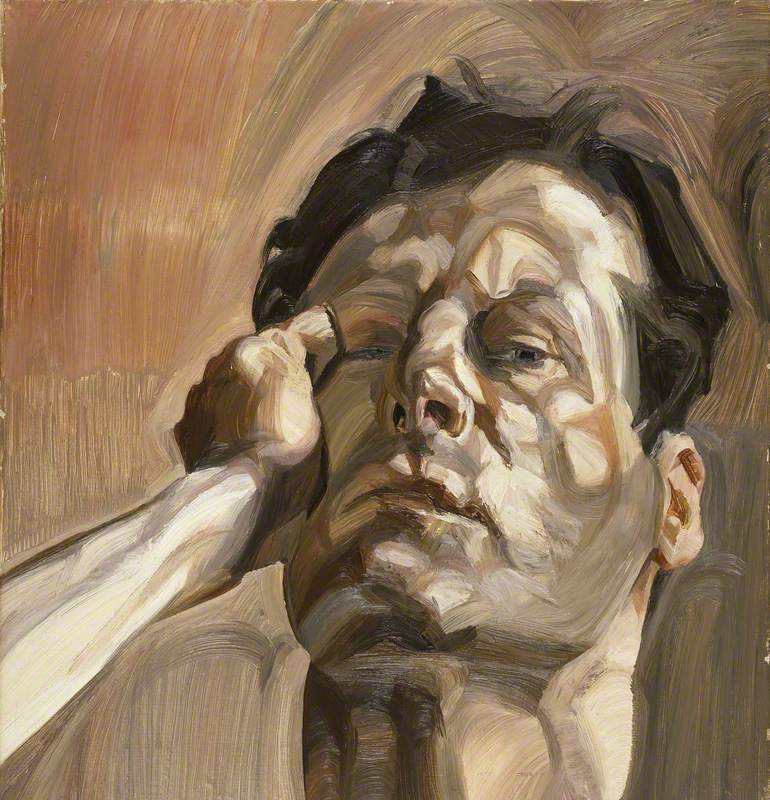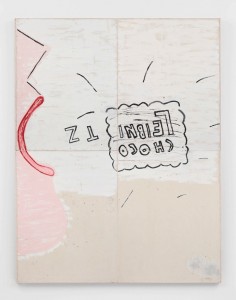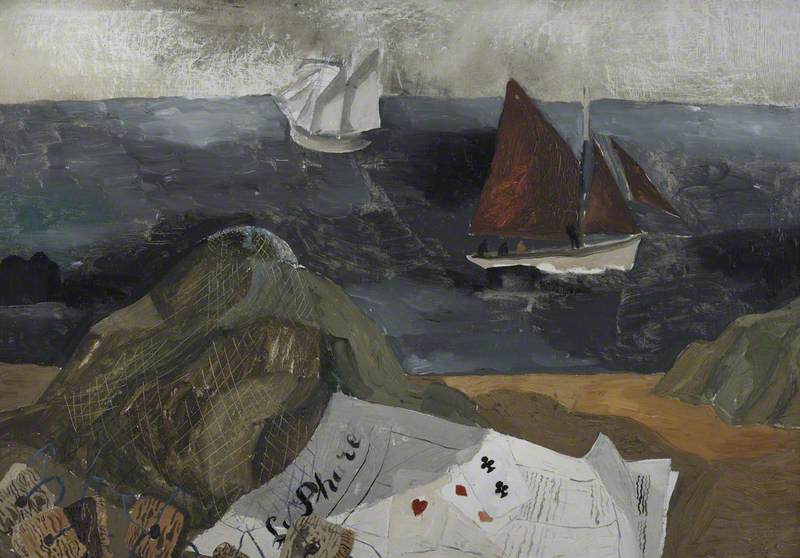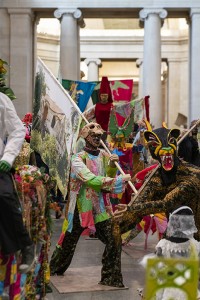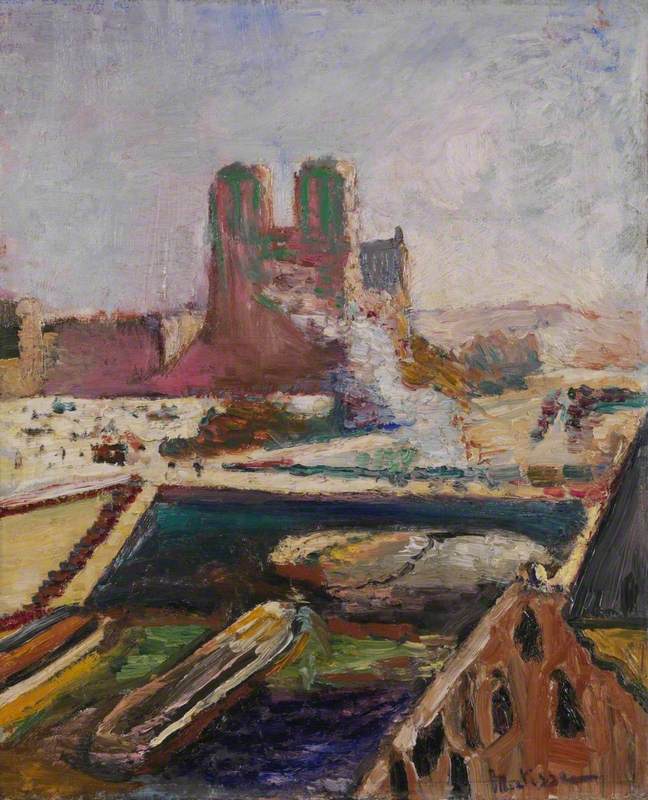Peter Doig is an artist – to be more specific, a figurative painter – of both cosmopolitan upbringing and vision. Britain, Trinidad, Canada, Germany: Doig's life experience in these countries is embedded in the fabric of his canvasses. He does not, however, paint from life. Having always felt like an outsider, he paints his idea of what a place is, spending a lot more time thinking about what and why to paint than painting itself.
According to Nicholas Serota, he possesses an incredible technique, and his paintings are richly textured, the result of relying on materials and reacting to what happens during the creative process: applying, scraping, thinning colour until he reaches the right feeling. He is not after perfection, and he likes his work to be alive, to possess an energy. He takes as long as it needs to finish a painting. Perhaps as a result of this, he is not particularly prolific.
Born in Scotland in 1959, Doig moved with his family to Trinidad in 1962 and then to Canada in 1966. In 1979 he went back to Europe to study art in London, at Wimbledon School of Art and St Martin's, after which he moved back to Canada.
Doig returned to London in his early thirties, where he attended a postgraduate course at Chelsea College of Art and started to establish himself within the British art scene. In 1993 he won the John Moores Painting Prize. In 1994 he won the Prix Eliette von Karajan (won the following year by Damien Hirst) and was nominated for the Turner Prize. In 2002, Doig returned to live in Trinidad.
Doig's use of big canvasses is to enable the viewer to experience the work's surface, to be part of it, and to convey an atmosphere. He has been compared to Caravaggio for his sense of theatricality but, unlike Caravaggio, whose scenes are very straightforward, Peter Doig's are deceptive, possessing a psychological substratum.
Doig sources his landscapes from photographs and memory. Just like Bonnard, Vuillard and Picasso before him, he uses photographs as a tool. His memory encompasses anything that catches his imagination: not only the feeling of a place but other artists' paintings, or films. We can see from as far back as his early works where different artists have provided inspiration. Early on, it was Canadian Tom Thomson and the Group Seven, followed by Edward Hopper and Edward Munch in the early 2000s, and more recently Gauguin and Matisse.
Cinema plays an important role too: in love with the medium since an early age, in 2003 Doig set up the Trinidad Studio Film Club, with free screenings every Thursday night for which he also paints the posters. Peter Doig thinks his paintings are certainly 'filmic', as cinema exercises a great influence on so many people, but that they also carry other layers of information, which go beyond the images depicted.
Since Doig met the poet Derek Walcott (Nobel Prize for Literature recipient in 1992) in 2013, poetry has become another source of inspiration. Joined by the shared experience of having lived in both Canada and Trinidad, Doig and Walcott decided to create something together to celebrate those places – and to celebrate life. This artistic collaboration has produced a colour book of 50 paintings and original poems titled Morning, Paramin.
Beautiful copies of 'Morning, Paramin' have arrived this morning! pic.twitter.com/ZkrIK1jvgL
— Faber Books (@FaberBooks) October 4, 2016
Doig's paintings have been described in numerous different ways, and on the whole, Doig has enjoyed a certain degree of critical success. Interestingly, one critic in particular wrote about Peter Doig's retrospective at Tate Britain in 2008 as being 'a trawl through mediocrity', but later apologised about those harsh comments and described his canvasses at his 2013 exhibition at the Scottish National Gallery as 'unabashedly, flamboyantly beautiful'.
This change of heart seems to have been reflected in the art market too. In fact, in the last decade, Peter Doig's big oil paintings have experienced an increasing commercial success in the resale market. It all started in June 2006 at Sotheby's in London with Iron Hill (1991): with an estimate of £400/600,000, the painting fetched £1,128,000.
The following year White Canoe (1990/1991) went for a whopping £5,732,000 – about which Peter Doig was reported to have felt nauseous. The prominence of the painting was perhaps what pushed the price to such heights: it was sold by Charles Saatchi, who bought the painting directly from Peter Doig in 1991.
Peter Doig’s monumental work The Architect's Home in the Ravine achieves £11,282,500 pic.twitter.com/GhxW2reLsE
— Christie's (@ChristiesInc) February 11, 2016
In February 2016 another record was set at Christie's in London: The Architect's Home in the Ravine (1991) fetched £11,281,500 and in November 2015, at Christie's in New York, Olin MK IV Part 2 (1995/1996) fetched $5,847,500 (£4,694,373).
The irony in all of this is that artists benefit only marginally from the exorbitant amounts reached at auction. Although within the European Economic Area artists are eligible to resale royalties, these are capped at €12,500, a sum reached when artworks are sold for €2,000,000 and above. Financially, Peter Doig can be considered a sound investment: for example, his painting Grasshopper (1990) increased in value almost three times in a period of eight years (from 2003 when it was sold at Sotheby's London for £229,600, to 2011 when it was sold at Sotheby's New York for $1,426,500/£896,555).
#AuctionUpdate Last sold for £894,130 in 2007, Peter #Doig’s ‘Grasshopper’ leaps off, tonight bringing £5.9m pic.twitter.com/8ztM08oj2j
— Sotheby's (@Sothebys) October 7, 2016
According to Artprice.com, Peter Doig's ranking in 2015 was 51: Damien Hirst 98, his friend (and neighbour in Trinidad) Chris Ofili 254, Tracey Emin 595. These comparisons aren't everything but it is interesting to observe the 'market value' of Peter Doig compared to these other artists, who were launched into fame as Young British Artists thanks to Charles Saatchi's 1998 'Sensation' exhibition at the Royal Academy – it is interesting to wonder why Peter Doig was not included, when Saatchi owned his White Canoe.
Possibly, a better comparison to a living European artist is Gerhard Richter, with whom Peter Doig shares his devotion to painting – and the high bids at auction for their earlier big paintings. Gerhard Richter's Artprice ranking is 12.
Notwithstanding the amount of money that his paintings fetch at auctions – the result of many volatile factors including taste, fashion, hype, speculation scarcity and merit – to answer the question at the beginning, I believe Peter Doig is a maverick in his enduring advocacy of figurative painting in an artistic world more and more involved in a frantic search for new ways of expression.
Perhaps most importantly, I believe Peter Doig is a painter who is seriously committed to the evolution and diffusion of art, which he fosters by nurturing the next generation of artists with his knowledge, experience and passion – an invaluable legacy.
Maria Grazia Bonfiglio, Art UK volunteer









